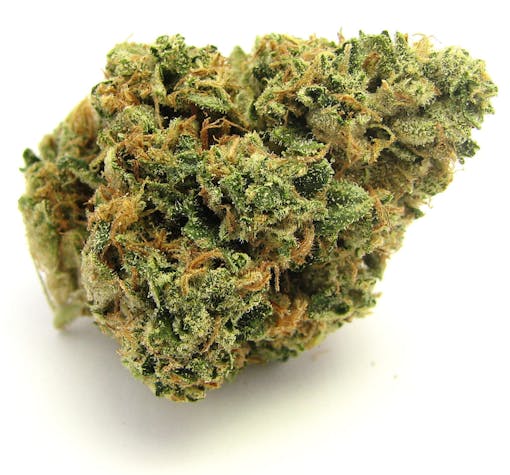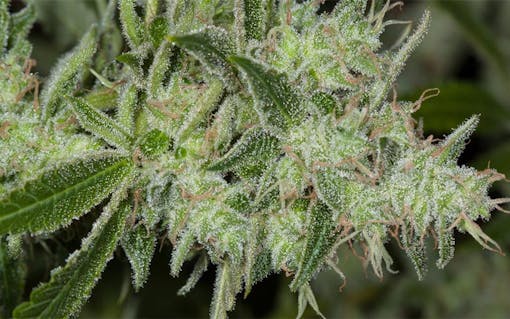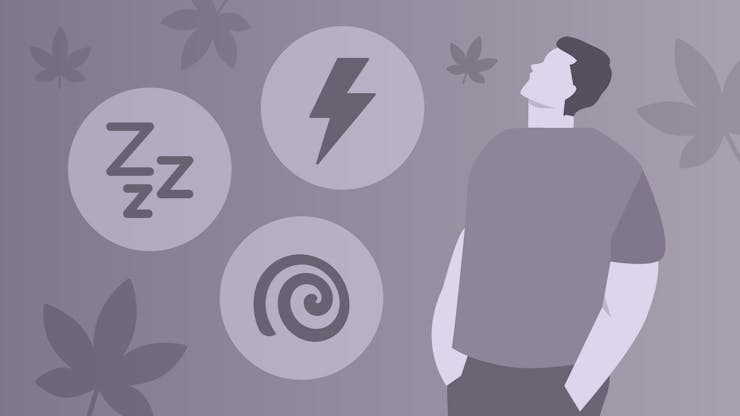A few years ago, some friends and I shared a joint around a fire. Fifteen minutes later, most of us were super mellow and chilled out. However, one of us got paranoid, refused to talk, and went to hide out in a dark room, and another (who, admittedly, smoked way more than her fair share) reported that she saw gremlins hiding in the bushes. As I surveyed my friends and myself, I wondered: How can one plant inspire so many different reactions?
Part of the appeal of cannabis is that it can encompass a range of different experiences. Technically, it’s a stimulant, a depressant, and a hallucinogen, all rolled into one humble, dankly scented plant.
The effects you experience when consuming cannabis depend on several factors, such as the unique chemical profile of the plant, or its composition of cannabinoids and terpenes. For some, a THC-heavy plant with fresh citrusy terpenes will deliver an uplifting, cerebral high. For others, a strain with equal parts THC and CBD can usher in feelings of deep relaxation.
What differentiates stimulants, depressants and hallucinogens?
Substances are commonly divided into four categories: stimulants, depressants, hallucinogens, and opioids. Stimulants can make you feel energetic, depressants can make you feel relaxed or sleepy, and hallucinogens can alter your perceptions of reality. These substances evoke different effects because they act on the pathways of the brain and body in unique ways.
Stimulants speed up the release of certain neurotransmitters such as dopamine, serotonin, and norepinephrine in the central nervous system. The central nervous system processes information and coordinates activity across the body. Depressants increase the activity of a distinct neurotransmitter, GABA. When GABA activity ramps up, the central nervous system slows down.
Hallucinogens work somewhat differently. A wide range of substances can enact hallucinogenic effects in different ways, but one mechanism that all hallucinogens share in common is the activation of 5-HT2A receptors. These receptors are a member of the serotonin receptor family.
Is weed a stimulant?
Stimulants are substances that stimulate or speed up central nervous system function. They can make you feel aware, alert, energetic, confident, and euphoric. Stimulants can also increase heart rate, elevate blood pressure, and lead to anxiety and paranoia.
The best known stimulant of all, caffeine, is available nearly everywhere. Other stimulants, such as cocaine or methamphetamine, are illegal and designated as controlled substances. Cannabis can be a stimulant too, elevating mood, increasing energy, and helping to feel focused, and for these reasons, people may experiment with weed before a social occasion, a creative project, or a challenging workout.
Research shows that THC can fire up dopamine release and can increase serotonin levels—but these effects are dependent on dose and use patterns. High doses of THC, or heavy long-term use, can have the opposite effect.
Anecdotal research suggests that strains primarily dominant in THC can help energize and stimulate. The presence of bright, uplifting terpenes can also play a role in providing a buzz. Zesty, citrusy notes, woody, pine aromas, and even the scent of tropical mango can also contribute to an energizing high.
Three weed strains with stimulant qualities



- Durban Poison: Referred to by some as the espresso of cannabis, THC-dominant Durban Poison is widely recognized to be one of the most energizing cultivars out there. Prevailing notes of fresh pine and candied lemon also help lift mood and enhance focus.
- Sour Diesel: Named for its skunky, diesel-like aroma, Sour D is also well known for its stimulating effects. Like Durban Poison, this cultivar is THC-dominant. Users often note that it delivers an energizing high that is also very cerebral.
- Green Crack: Dubiously named Green Crack is another go-to cultivar for those seeking an invigorating buzz. With 17% THC and an aroma of mango (thanks to its myrcene content), Green Crack is sometimes likened to a tropical energy drink.
Is weed a depressant?
Cannabis can also be categorized as a depressant, along with alcohol, benzodiazepines, and other substances. Research shows that cannabinoids influence GABA levels: In an animal study, for example, cannabis increased GABA activity. In a clinical trial on humans with and without autism spectrum disorder (ASD), CBD elevated GABA levels among those without ASD. As mentioned earlier, when GABA activity speeds up, central nervous system function slows down, so the pace at which messages are passed between the brain and body also decreases.
In other words, depressants produce opposing effects to stimulants and can relax muscles, calm nerves, and make a person feel mentally chilled out. High doses of depressants, however, can make consumers feel drowsy, and can detrimentally influence coordination and concentration. It’s little surprise then, that smoking a ton of weed and driving can be potentially fraught with danger.
Weed with a higher proportion of CBD to THC can create feelings of relaxation without inducing couch lock. On the other hand, weed with a slightly higher ratio of THC to CBD can deliver a more sedative experience. A sprinkle of anxiety-easing terpenes or minor cannabinoids, like CBG, can further heighten relaxation.
Three strains with depressant qualities



- OG Kush: With its earthy, woody tones, OG Kush is beloved by many for its grounding, down-to-earth, stress-releasing vibes. OG Kush is THC-dominant, so for some it may lead to heavy eyelids or couch lock.
- Granddaddy Purple: This well known cultivar delivers a fusion of cerebral euphoria, profound bodily relaxation, and semi-sedative effects. With deep purple buds, Granddaddy Purp emits an aroma evocative of grapes and berries.
- Cannatonic: CBD-dominant Cannatonic provides a tonic to life’s stressors, inducing sensations of profound bodily relaxation. Many consumers lean on this earthy cultivar as a super smooth antidote to anxiety.
Is weed a hallucinogen?
While there has been some contention about whether weed qualifies as a hallucinogen or not, the consensus is that cannabis can induce hallucinogenic effects. Hallucinogens (also known as psychedelics) are substances that cause changes to perception, mood, and thought processes. Some common psychedelics include psilocybin mushrooms or LSD.
Psychedelics can cause a range of effects, including an altered sense of time, intensified emotions, or seeing things that appear distorted or do not exist. They can also affect the body physically, increasing blood pressure and breathing rate. Similar to stimulants, high doses of hallucinogens can cause anxiety and paranoia.
Cannabis doesn’t always cause hallucinogenic effects, but when it does, they’re generally linked to strains high in THC. A recent study also suggested that tripping tends to occur after consuming very high doses of delta-9 THC by itself, rather than whole-plant cannabis with a mix of cannabinoids and terpenes. The same study also suggested that cannabis might induce psychedelic effects differently from other psychedelics, with more muted effects on emotion and thought processes.
Three strains with hallucinogenic qualities


Super Lemon Haze: With around 19% THC, this sweet yet zesty cultivar produces a potent, semi-psychedelic high that quickly hits home. Super Lemon Haze is a member of the Haze family of cultivars, known for producing trippy effects.
LSD weed strain: It’s not probably that surprising that a weed strain with “LSD” in the name is known for its hallucinogenic properties. The weed strain LSD has developed a reputation for giving consumers a potent euphoric and cerebral high, redolent of an acid trip.
Trippy Gorilla: Like its name, this THC-heavy cultivar (with more than 25% THC) offers a quirky, trippy experience. Consumers who have tried Trippy Gorilla report mild visual alterations, euphoric feelings, and an altered sense of time and space.
Psychedelic effects are also often experienced by when consuming the hemp-derived compound THC-O. Believed to be up to three times as potent as delta-9 THC, this cannabinoid is making waves among consumers seeking a powerful psychedelic experience. However, there’s currently contention about the legality of THC-O and concerns about its safety.
What other factors influence the effects of weed?
As illustrated above, weed traverses the boundaries of stimulants, depressants, and hallucinogens; it’s a versatile little plant. While the chemical profile of distinct strains influences whether it causes relaxing or enlivening effects, other factors play a role too.
Diverse factors such as an individual’s body fat and metabolism, delivery method, personal tolerance, and even age can subtly (or significantly) influence how a person responds to weed—which means that the same strain can affect people differently. However, one of the most influential factors is dose.
Both CBD and THC produce dose-dependent effects. For example, a low dose of CBD tends to alleviate anxiety, while a high dose can ramp it up. Similarly, another study showed that a low amount of THC (7.5 mg) helped individuals mellow their response to stress, while a high dose (12.5mg) increased anxiety, distress, and negative mood.
In general, the rule of thumb is to start low and go slow, allowing yourself time to observe and adjust to the effects of cannabis. Then, once you’re familiar with your personal tolerance and baseline dosage, you can start experimenting with dosage and different strains to achieve stimulant, depressant, or even psychedelic effects.





